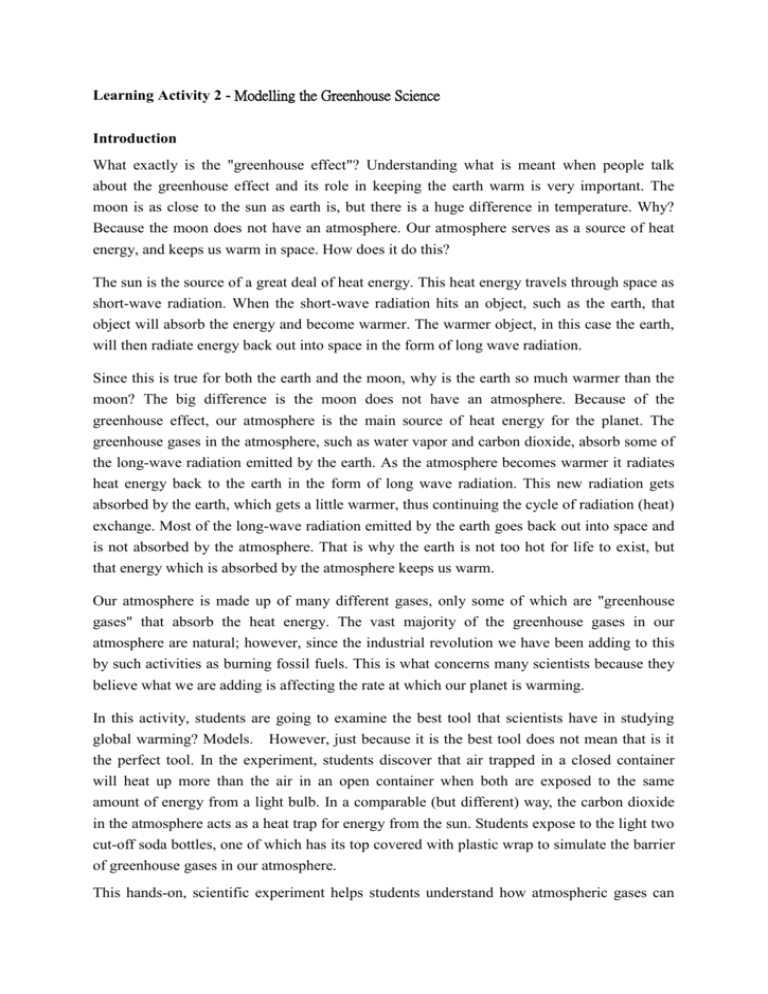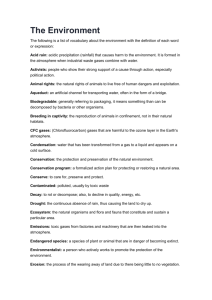Learning Activity 2 - Modelling the Greenhouse Science
advertisement

Learning Activity 2 - Modelling the Greenhouse Science Introduction What exactly is the "greenhouse effect"? Understanding what is meant when people talk about the greenhouse effect and its role in keeping the earth warm is very important. The moon is as close to the sun as earth is, but there is a huge difference in temperature. Why? Because the moon does not have an atmosphere. Our atmosphere serves as a source of heat energy, and keeps us warm in space. How does it do this? The sun is the source of a great deal of heat energy. This heat energy travels through space as short-wave radiation. When the short-wave radiation hits an object, such as the earth, that object will absorb the energy and become warmer. The warmer object, in this case the earth, will then radiate energy back out into space in the form of long wave radiation. Since this is true for both the earth and the moon, why is the earth so much warmer than the moon? The big difference is the moon does not have an atmosphere. Because of the greenhouse effect, our atmosphere is the main source of heat energy for the planet. The greenhouse gases in the atmosphere, such as water vapor and carbon dioxide, absorb some of the long-wave radiation emitted by the earth. As the atmosphere becomes warmer it radiates heat energy back to the earth in the form of long wave radiation. This new radiation gets absorbed by the earth, which gets a little warmer, thus continuing the cycle of radiation (heat) exchange. Most of the long-wave radiation emitted by the earth goes back out into space and is not absorbed by the atmosphere. That is why the earth is not too hot for life to exist, but that energy which is absorbed by the atmosphere keeps us warm. Our atmosphere is made up of many different gases, only some of which are "greenhouse gases" that absorb the heat energy. The vast majority of the greenhouse gases in our atmosphere are natural; however, since the industrial revolution we have been adding to this by such activities as burning fossil fuels. This is what concerns many scientists because they believe what we are adding is affecting the rate at which our planet is warming. In this activity, students are going to examine the best tool that scientists have in studying global warming? Models. However, just because it is the best tool does not mean that is it the perfect tool. In the experiment, students discover that air trapped in a closed container will heat up more than the air in an open container when both are exposed to the same amount of energy from a light bulb. In a comparable (but different) way, the carbon dioxide in the atmosphere acts as a heat trap for energy from the sun. Students expose to the light two cut-off soda bottles, one of which has its top covered with plastic wrap to simulate the barrier of greenhouse gases in our atmosphere. This hands-on, scientific experiment helps students understand how atmospheric gases can turn our planet into a giant greenhouse, causing global warming. Learning Objectives After completing this activity, the student will be able to construct a model analogous to the atmospheric greenhouse effect. relate how the closure of the atmosphere will heat up the surface of the earth. predict what the trend of temperature is. practice reading and recording data. interpret & analyze scientific data and graph the results. draw a conclusion and either approve or disprove their hypothesis. Materials For each team of four students: two 2-liter clear plastic soda bottles two thermometers three strips of thin cardboard, 1" x 2" four cups potting soil two colored markers one medium rubber band one piece of 20" x 20" plastic wrap masking tape one 100-watt light bulb one clip-on or unshaded desk lamp one wooden block for securing lamp (if needed) four pieces of 1/4" graph paper Instructions to Students 1. Bring in plastic soda bottles, enough for each group to have two bottles. Remove labels and cut off the tops. (See the diagram of the model.) 2. Cut the 1" x 2" pieces from a thin piece of cardboard, three for each team. 3. Gather the materials listed above. 4. Follow the experimental procedure stated in the laboratory sheet. Web Sites 1. 2. 3. http://www.pbs.org/audubon/wildwings/greenhouse.html http://www.kie.berkeley.edu/ned/data/E01-951006-002/full.html http://www.suite101.com/article.cfm/15285/89666








